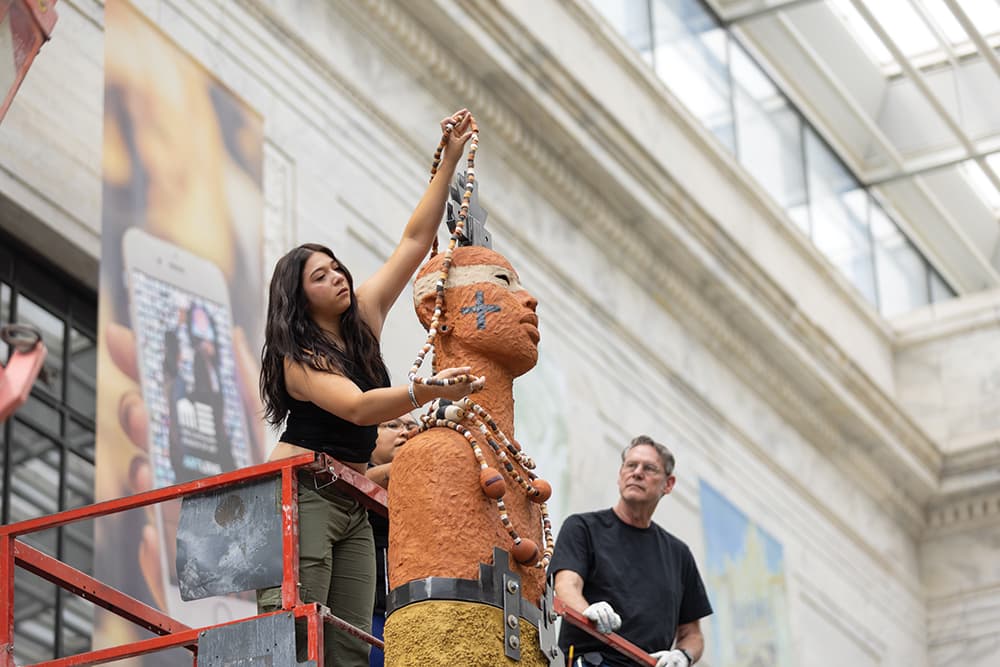
Rose B. Simpson’s Strata
- Magazine Article
- Exhibitions
Conversation through sculpture and space

Strata installation by Celestial Sena and Wanda Abeyta, studio assistants for Rose B. Simpson, with Barry Austin, CMA art handler and installation specialist
Throughout the history of art, artists have left titles for their creations on the backs of canvases, in journals, or through documented oral histories. Contemporary artists at times directly inform art historians and curators about artwork titles. Artist Rose B. Simpson (Santa Clara Pueblo, b. 1983) gave the site-specific sculptural duo on view through April 13, 2025, in the Ames Family Atrium a meaning through its title: Strata.
Strata, the plural term for stratum, can be defined in two ways: It can be rock and earth layered in sheets against each other. It can also be a segment representing an era of development in social history. Simpson adopts both meanings within her sculptural duo. On the inside of the sculptures, layers of rocks fill the base, and metal armature acts as the structural support. However, the exterior consists of steel, pumice, concrete, bronze, and clay. As her primary medium, clay is both a material and a vessel for Simpson’s creative expression. With an intimate connection to the earth and a profound understanding of her ancestral Pueblo heritage, she transforms the clay material into sculptures that transcend mere form; they become active carriers of cultural narratives and echoes of her personal journey. The tactile nature of Simpson’s process is evident in the fingerprints and markings that leave a lasting imprint on each sculpture. Just as the material can be molded and reimagined, Strata, and largely Simpson’s artistic portfolio, reflects the ability to adapt traditional forms to address contemporary developments and social challenges.
Simpson emphasizes the fact that her artistic journey is fundamentally a quest for tools to address the complexities of a decolonial contemporary society. Through its presence in the Ames Family Atrium, Strata not only bears witness to narratives of the past but vests viewers with ag-ency, fostering a sense of resilience, empowerment, and change. Nadiah Rivera Fellah, curator of contemporary art, highlights how Simpson’s “large-scale sculptures represent a bold intervention in colonial legacies of erasure of the identities and ways of life of Indigenous people. Her work asserts a pride of place and belonging on land where Native residents have historically been forcefully dispossessed of their territories and cultures.”

In the installation process, one of the key elements that designers consider is the spatial arrangement of an artwork. Logistically, the grandeur of Strata, with two sculptures measuring 26 feet each, presented a new opportunity for museum staff and Simpson to bring the sculptures to life in the Ames Family Atrium. Joe Blaser, senior art handler, said that “every project is a little different, with different needs, people, and materials we are working with. Being able to see each component from Simpson’s sketches made it easier to understand how we could safely move the art. It’s always interesting to work with new tools, such as the mini crane from a landscape contractor that enabled us to safely lift each of the parts to make the two large sculptures.”

For Strata, each sculpture has four distinct parts: the base with rocks, the legs and torso, the shoulders and head, and the headdress and accessories. A collaboration among the artist, her studio assistants, and CMA staff helped each aspect of the installation to be executed seamlessly. At the end of two long days of installation in early July, Simpson sat with friends and family as they gazed back and forth between the two sculptures. After years of hard work and creativity, it was the first time they had seen Strata in its final form.
While a visitor might not actively think about it while they are moving through the museum, the way the body interacts with the space can be meaningful. Strata exemplifies this, as Simpson hopes that moving throughout the atrium around her work “allows visitors to begin to feel the influence of intention in artistic objects in their bodies, so that they are transformed by that and can witness the rest of the museum in a different way—seeing artistic creations as beings other than objects.” While the two figures stand still in time, it is the visitor’s interaction with the work that makes Strata truly come to life.